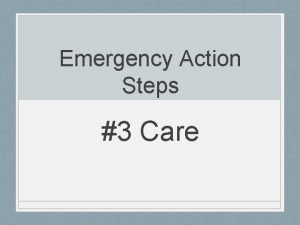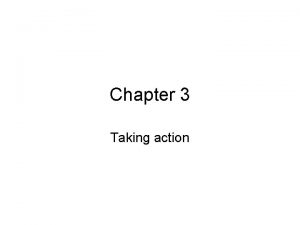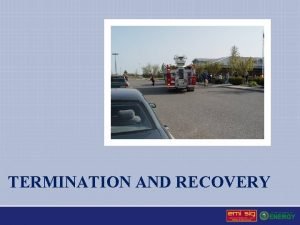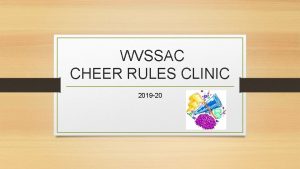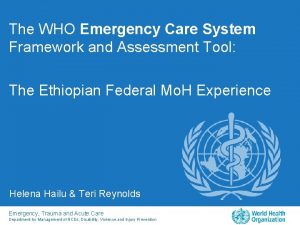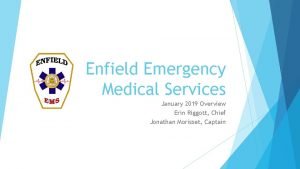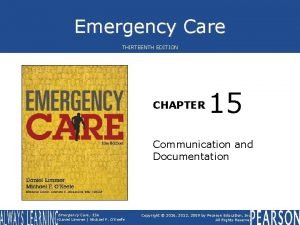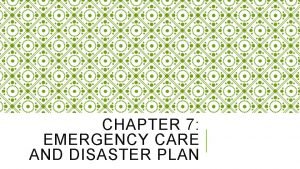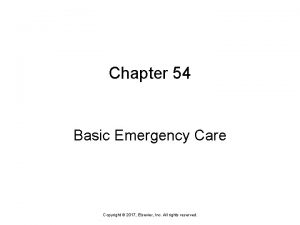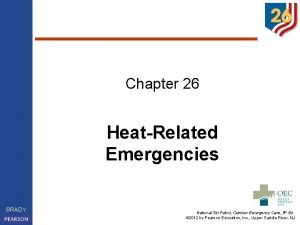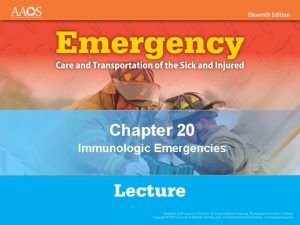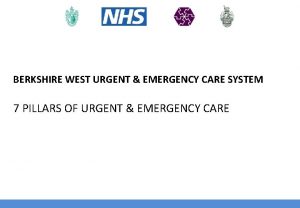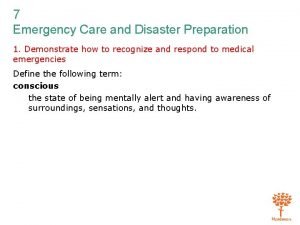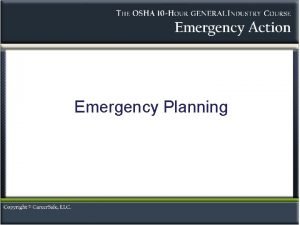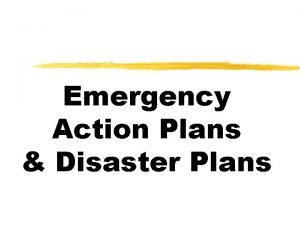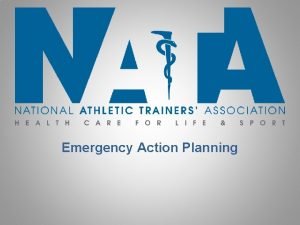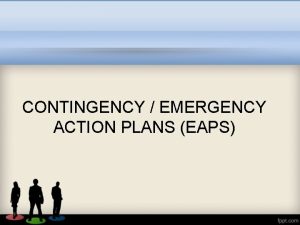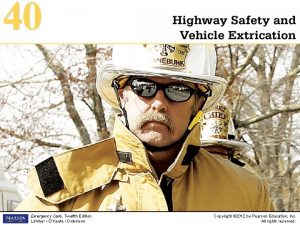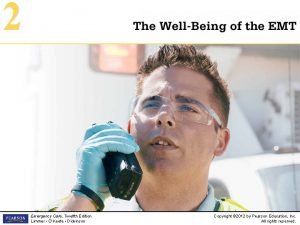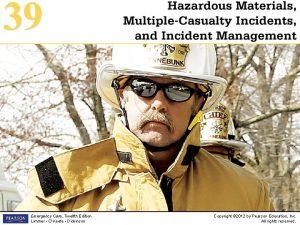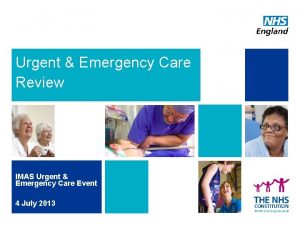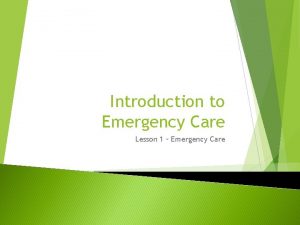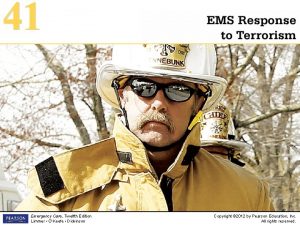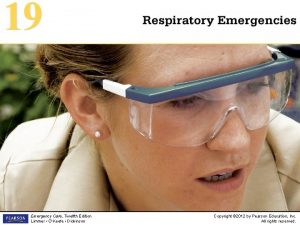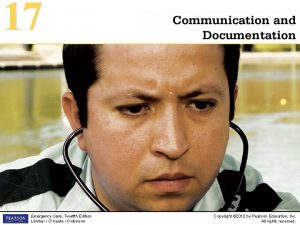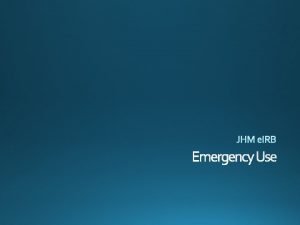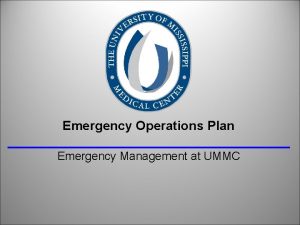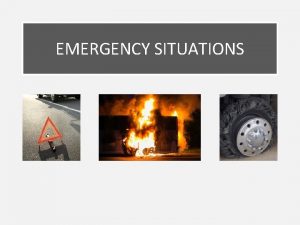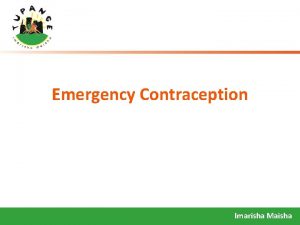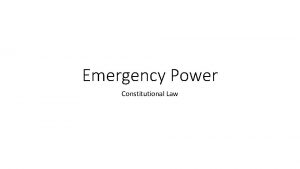Emergency Action Steps 3 Care What to do





















- Slides: 21

Emergency Action Steps #3 Care

What to do… • Check: The scene then the victim • Call: 911 if the situation is life threatening • Care: For the victim • Make sure to put on gloves if they are available before helping the victim • Do you need any other safety equipment? Goggles? Facemask? • Have you taken off your jewelry and covered any open wounds?

Severe Bleeding • Apply direct pressure to the wound using a sterile gauze pad or a clean, absorbent cloth. • If gloves aren’t available, have the victim apply pressure on the wound if possible. • While continuing to apply pressure, raise the wound above the victims heart (unless you suspect a fracture)… this helps slow the bleeding down.

Severe Bleeding • Make a “pressure bandage” by snuggly wrapping an elastic bandage over the pad • If bleeding continues apply additional bandages on top of the existing ones • DON’T REMOVE PREVIOUS BANDAGES! • Immobilize the injured body part after bleeding has stopped Severe Bleeding

Open Fracture • Cut away clothing from injured area. DO NOT try to push the bone back into the skin • Apply gentle pressure with a large sterile pad to control bleeding (don’t push directly on the exposed bone) • Cover the entire area with a sterile bandage or clean cloth • If a victim needs to be moved before help arrives, apply a splint to immobilize the injured area Open Fracture

Closed Fracture • Remember – you don’t need to call 911 unless the situation is life threatening • Immobilize the injured area with a sling or splint • Apply ice or a cold compress for 10 -15 minute intervals and keep victim still and comfortable until receiving medical attention

Muscle Strain/Sprain 911 is not necessary! • R – Rest the injured area and avoid using it • I – Ice (immobilize) the area within the first 24 hours to avoid swelling • C – Compress (cold) the area with elastic wrap • E – Elevate the area to prevent or reduce swelling

Conscious Choking • First, ask “Are you choking? ” • If the victim can respond, encourage them to keep coughing. • If the victim can not respond, give them 5 back blows and perform 5 abdominal thrusts • This is the Heimlich Maneuver

Heimlich Maneuver • Stand behind the victim • Wrap both arms around the upper part of the victim’s abdomen, just below the rib cage • Make a fist with one hand place it (thumb inward) on the victims abdomen • Between the naval and breastbone • Grasp your fist with your other hand pull sharply inward and upward • Continue (providing 5 back blows and 5 abdominal thrusts) until the object becomes dislodged, the victim begins to cough or breathe, or becomes unconscious • If the victim becomes unconscious, call 911 then begin CPR

Unconscious and Breathing Put the victim in the recovery position on his or her side and continue to monitor until EMS arrives.

Cardiac Chain of Survival

Early Access • Recognize the Sudden Cardiac Arrest emergency and call 911. Recognizing the warning signs of SCA is vital in treating it successfully. • • Unresponsiveness Loss of consciousness Lack of pulse No breathing • An immediate call to 911 helps ensure that an advanced life support response team will get to the victim more quickly.

Early CPR • Providing CPR (Cardiopulmonary Resuscitation) compressions and breaths keeps oxygenated blood flowing through the heart and brain (the body’s most vital organs). • Early CPR increases the chances of survival but it alone cannot save an SCA victim. • If the responder has not been CPR certified, they may be able to receive assistance from the 911 emergency dispatcher. • Dispatchers in many parts of the country are trained to coach callers through the basic steps of CPR. Remember, CPR should be started immediately!

Early Defibrillation • Defibrillation is the only way to stop sudden cardiac arrest. • When SCA occurs, the heart must be restarted by an electrical shock. Outside a hospital setting, the only way to restart the heart is by using an automated external defibrillator (AED). • Having one nearby or on the emergency vehicle when it arrives is vital. When an AED is used and electrodes are placed on the victim’s chest, electricity flows from the electrodes through the chest to the heart. For each minute that passes between collapse and defibrillation, SCA survival rates can decrease from seven to ten percent. Responders should use an AED as soon as possible to increase the chance of survival. American Red Cross – Using an AED

Early Advanced Care • Advanced care, after using the AED, is given to the patient by paramedics and other highly trained medical personnel on scene and when the SCA victim is being transported to the hospital. • Advanced care is necessary to help maintain a normal heart rhythm after successful defibrillation.

Signals of a Heart Attack • Chest pain or pressure • Pain spreading to the shoulders, neck, jaw, stomach, or arms • Nausea or vomiting • Dizziness or lightheadedness • Pale, grayish, or bluish skin • Sweating • Denial of symptoms What Happens During a Heart Attack

Unconscious and not Breathing • Kneel beside the victim • Look, listen, and feel for normal signs of breathing • If the victim is not breathing normally place the heel of your hand in the center of the victims chest • Place your other hand on top of your first hand interlock your fingers. Keep your fingers raised off the victims chest • Lean over the victim so your shoulders are above your hands and straighten your arms

Unconscious and not Breathing • Press down on the breastbone to compress the chest by 2 inches. Then, release the • pressure without removing your hands from the victims chest • Compress the chest 30 times at the rate of 2 compressions per second. • If you are not certified, just perform continuous chest compressions at a rate of 100 -120 compression per minute Continue CPR until medical help arrives and takes over, an AED can be located and used, there are signs of life, the scene becomes unsafe, if someone else takes over, or you are too tired to continue IF YOU ARE CERTIFIED, PERFORM RESCUE BREATHS • Establish a cycle of 2 rescue breaths and 30 chest compressions. • Five cycles of chest compressions should take about two minutes AHA - CPR

Unconscious Choking • Provide 30 chest compressions • Grasp tongue and lower jaw between the thumb and forefinger and look into the mouth • If you see an object, make a scooping motion with your finger in the victims mouth/throat to retrieve the object • If you do not see an object, open airway and perform two rescue breaths • Repeat until item is dislodged and victim begins breathing or medical help arrives. Unconscious Adult Choking

Continue Until… Continue providing first aid until one of the following occurs: • The scene becomes unsafe • Someone else takes over for you • You are too tired to continue • Medical help arrives

Review • Go to http: //www. firstaidweb. com/ • Click on the links for BOTH First Aid and CPR • Read through each of the short chapters and take the quiz at the end of the section (4 total) • You must get a passing score before moving on to the next chapter • Screen shot each of your scores onto one Word document and turn in when finished.
 What are 3 emergency action steps
What are 3 emergency action steps 3 emergency action steps
3 emergency action steps Cprfa
Cprfa Primary secondary and tertiary health care
Primary secondary and tertiary health care Emergency action plan swimming pool
Emergency action plan swimming pool Drowning emergency action plan
Drowning emergency action plan Emergency action termination
Emergency action termination Wvssac emergency action plan
Wvssac emergency action plan Who emergency care system framework
Who emergency care system framework The standards of prehospital emergency care
The standards of prehospital emergency care Prehospital emergency care 11th edition
Prehospital emergency care 11th edition Emergency care and first aid ppt
Emergency care and first aid ppt Emergency care enfield
Emergency care enfield Emergency care 13th edition chapter 1
Emergency care 13th edition chapter 1 Chapter 7 emergency care and disaster preparation
Chapter 7 emergency care and disaster preparation Chapter 54 basic emergency care
Chapter 54 basic emergency care Outdoor emergency care 6th edition
Outdoor emergency care 6th edition Care for a victim of an immunologic emergency
Care for a victim of an immunologic emergency 7 pillars of urgent and emergency care
7 pillars of urgent and emergency care Emergency care first aid and disasters
Emergency care first aid and disasters Chapter 7 emergency care and disaster preparation
Chapter 7 emergency care and disaster preparation Prehospital care 11th edition
Prehospital care 11th edition
